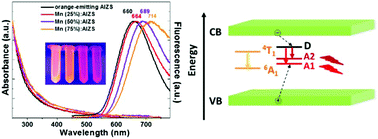Highly fluorescent, color tunable and magnetic quaternary Ag–In–Mn–Zn–S quantum dots†
Abstract
Mn-Doped quantum dots (QDs) are of high interest for numerous applications like solar cells, optoelectronics, optosensing, or bioimaging. Here, we report the preparation of quaternary (AgInS2)x(MnS)y(ZnS)1−x−y QDs, thereafter noted Mn : AIZS via a thermally induced decomposition of Ag, In, Zn and Mn precursors in the presence of oleylamine and dodecanethiol. The Mn : AIZS QDs have an average diameter of 3.5 nm and their XRD patterns can be indexed with the orthorhombic phase of AgInS2. The incorporation of Mn2+ ions in the AIZS crystal lattice results in a red-shift of the photoluminescence (PL) emission maximum depending on the Mn2+ content. The PL quantum yields decrease upon loading with Mn2+ but remained high (53–31%) until 50% theoretical loading in Mn2+. Steady state, PL excitation and time-resolved PL measurements suggest that Mn2+-dependent trap states are involved in the PL emission. Mn : AIZS QDs exhibit also magnetic properties. In addition, Mn : AIZS QDs can easily be transferred to the aqueous phase using the PMAO amphiphilic polymer without alteration of their optical properties (PL quantum yield up to 51%), revealing their high potential for biological applications.



 Please wait while we load your content...
Please wait while we load your content...